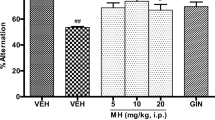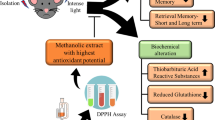Abstract
Stress occurs in everyday life and persistence of it causes memory loss. Bioflavonoids like quercetin are reported to have poor bioavailability and limited therapeutic potential against stress induced neurological disorders. Therefore, the present study is an attempt to elucidate the therapeutic potency of combination of quercetin with piperine; a bioavailability enhancer against chronic unpredictable stress (CUS)-induced behavioral and biochemical alterations. Laca mice were subjected to a series of stressful events for a period of 28 days. Quercetin (20, 40 and 80 mg/kg, p.o.), piperine (20 mg/kg, p.o.) and their combinations were administered daily 30 min before CUS procedure. Piracetam (100 mg/kg, i.p.) served as a standard control. CUS caused impaired spatial navigation in Morris water maze test and poor retention in elevated plus maze task. Further, there was significant increase in brain oxidative stress markers and neuro-inflammation (TNF-α). This was coupled with marked rise in acetylcholinesterase and serum corticosterone levels. Co-administration of piperine with quercetin significantly elevated their potential to restore these behavioral, biochemical and molecular changes associated with mouse model of CUS. These results suggest that piperine enhances the neuroprotective effects of quercetin against CUS-induced oxidative stress, neuro-inflammation and memory deficits.





Similar content being viewed by others
References
Ader, P., A. Wessmann, and S. Wolffram. 2000. Bioavailability and metabolism of the flavonol quercetin in the pig. Free Radical Biology & Medicine 28: 1056–1067.
Anand, P., and B. Singh. 2013. A review on cholinesterase inhibitors for Alzheimer’s disease. Archives of Pharmacal Research 36: 375–399.
Atal, C.K., R.K. Dubey, and J.J. Singh. 1985. Biochemical basis of enhanced drug bioavailability by piperine: Evidence that piperine is a potent inhibitor of drug metabolism. Journal of Pharmacology and Experimental Therapeutics 232: 258–262.
Bhatia, N., A.S. Jaggi, N. Singh, P. Anand, and R. Dhawan. 2011. Adaptogenic potential of curcumin in experimental chronic stress and chronic unpredictable stress-induced memory deficits and alterations in functional homeostasis. Journal of Natural Medicines 65: 532–543.
Bhutada, P., Y. Mundhada, K. Bansod, C. Bhutada, S. Tawari, P. Dixit, and D. Mundhada. 2010. Ameliorative effect of quercetin on memory dysfunction in streptozotocin-induced diabetic rats. Neurobiology of Learning and Memory 94: 293–302.
Bhutani, M.K., M. Bishnoi, and S.K. Kulkarni. 2009. Anti-depressant like effect of curcumin and its combination with piperine in unpredictable chronic stress-induced behavioral, biochemical and neurochemical changes. Pharmacology, Biochemistry and Behavior 92: 39–43.
Choi, J.S., Y.J. Piao, and K.W. Kang. 2011. Effects of quercetin on the bioavailability of doxorubicin in rats: Role of CYP3A4 and P-gp inhibition by quercetin. Archives of Pharmacal Research 34: 607–613.
Churchwell, J.C., A.M. Morris, N.D. Musso, and R.P. Kesner. 2010. Prefrontal and hippocampal contributions to encoding and retrieval of spatial memory. Neurobiology of Learning and Memory 93: 415–421.
Ellman, G.L. 1959. Tissue sulfhydryl groups. Archives of Biochemistry and Biophysics 82: 70–77.
Ellman, G.L., V. Courtney, and R.M. Andres. 1961. A new and rapid colorimetric determination of acetylcholinesterase activity. Biochemical Pharmacology 7: 88–95.
Farooq, R.K., E. Isingrini, A. Tanti, A.M. Le Guisquet, N. Arlicot, F. Minier, S. Leman, S. Chalon, C. Belzung, and V. Camus. 2012. Is unpredictable chronic mild stress (UCMS) a reliable model to study depression-induced neuroinflammation? Behavioural Brain Research 231: 130–137.
Gornall, A.G., C.J. Bardawill, and M.M. David. 1949. Determination of serum proteins by means of the biuret reaction. The Journal of Biological Chemistry 177: 751–766.
Green, L.C., D.A. Wagner, and J. Glagowski. 1982. Analysis of nitrate, nitrite and (15N) nitrate in biological fluids. Analytical Biochemistry 126: 131–138.
Hanasaki, Y., S. Ogawa, and S. Fukui. 1994. The correlation between active oxygens scavenging and antioxidative effects of flavonoids. Free Radical Biology & Medicine 16: 845–850.
Joels, M. 2006. Corticosteroid effects in the brain: U-shape it. Trends in Pharmacolgical Sciences 27: 244–250.
Johnson, J.J., M. Nihal, I.A. Siddiqui, C.O. Scarlett, H.H. Bailey, H. Mukhtar, and N. Ahmad. 2011. Enhancing the bioavailability of resveratrol by combining it with piperine. Molecular Nutrition & Food 55: 1169–1176.
Kawabata, K., Y. Kawai, and J. Terao. 2010. Suppressive effect of quercetin on acute stress-induced hypothalamic–pituitary–adrenal axis response in Wistar rats. The Journal of Nutritional Biochemistry 21: 374–380.
Keller, J.N., F.A. Schmitt, S.W. Scheff, Q. Ding, Q. Chen, D.A. Butterfield, and W.R. Markesbery. 2005. Evidence of increased oxidative damage in subjects with mild cognitive impairment. Neurology 64: 1152–1156.
Kumar, A., and R. Goyal. 2008. Quercetin protects against acute immobilization stress-induced behaviors and biochemical alterations in mice. Journal of Medicinal Food 11: 469–473.
Kumar, A., N. Sehgal, P. Kumar, S.S. Padi, and P.S. Naidu. 2008. Protective effect of quercetin against ICV colchicine-induced cognitive dysfunctions and oxidative damage in rats. Phytotherapy Research 22: 1563–1569.
Kono, Y. 1978. Generation of Superoxide radical during auto-oxidation of hydroxylamine and an assay for superoxide dismutase. Archives of Biochemistry and Biophysics 186: 189–195.
Kurukulasuriya, R., B.K. Sorensen, J.T. Link, J.R. Patel, H.S. Jae, M.X. Winn, J.R. Rohde, N.D. Grihalde, C.W. Lin, C.A. Ogiela, A.L. Adler, and C.A. Collins. 2004. Biaryl amide glucagon receptor antagonists. Bioorganic & Medicinal Chemistry Letters 14: 2047–2050.
Lucca, G., C.M. Comim, S.S. Valvassori, G.Z. Réus, F. Vuolo, F. Petronilho, F. Dal-Pizzol, E.C. Gavioli, and J. Quevedo. 2009. Effects of chronic mild stress on the oxidative parameters in the rat brain. Neurochemistry International 54: 358–362.
Luck, H. 1971. Catalase. In Methods of Enzymatic Analysis, ed. H.U. Bergmeyer, 885–893. New York: Academic.
Massaad, C.A., and E. Klann. 2011. Reactive oxygen species in the regulation of synaptic plasticity and memory. Antioxidants & Redox Signaling 14: 2013–2054.
Molina, M.F., I. Sanchez-Reus, I. Iglesias, and J. Benedi. 2003. Quercetin, a flavonoid antioxidant, prevents and protects against ethanol-induced oxidative stress in mouse liver. Biological & Pharmaceutical Bulletin 26: 1398–1402.
Moorthi, C., K. Krishnan, R. Manavalan, and K. Kathiresan. 2012. Preparation and characterization of curcumin-piperine dual drug loaded nanoparticles. Asian Pacific Journal of Tropical Biomedicine 2: 841–848.
Moreira, P.I., X. Zhu, Q. Liu, K. Honda, S. Siedlak, P.L. Harris, M.A. Smith, and G. Perry. 2006. Compensatory responses induced by oxidative stress in Alzheimer disease. Biological Research 39: 7–13.
Morris, R.G.M. 1984. Developments of a water maze procedure for studying spatial learning in the rats. Journal of Neuroscience Methods 11: 47–60.
Murua, V.S., R.A. Gomez, M.E. Andrea, and V.A. Molina. 1991. Shuttle-box deficits induced by chronic variable stress: Reversal by imipramine administration. Pharmacology, Biochemistry and Behavior 38: 125–130.
Nijholt, I., N. Farchi, M. Kye, E.H. Sklan, S. Shoham, B. Verbeure, D. Owen, B. Hochner, J. Spiess, H. Soreq, and T. Blank. 2004. Stress-induced alternative splicing of acetylcholinesterase results in enhanced fear memory and long-term potentiation. Molecular Psychiatry 9: 174–183.
Pachauri, S.D., S. Tota, K. Khandelwal, P.R. Verma, C. Nath, K. Hanif, R. Shukla, J.K. Saxena, and A.K. Dwivedi. 2012. Protective effect of fruits of Morinda citrifolia L. on scopolamine induced memory impairment in mice: A behavioral, biochemical and cerebral blood flow study. Journal of Ethnopharmacology 139: 34–41.
Radley, J.J., H.M. Sisti, A.B. Rocher, J. Hao, T. McCall, P.R. Hof, B.S. McEwen, and J.H. Morrison. 2004. Chronic behavioral stress induces apical dendritic reorganization in pyramidal neurons of the medial prefrontal cortex. Neuroscience 125: 1–6.
Roozendaal, B. 2002. Stress and memory: Opposing effects of glucocorticoids on memory consolidation and memory retrieval. Neurobiology of Learning and Memory 78: 578–595.
Sato, H., T. Takahashi, K. Sumitani, H. Takatsu, and S. Urano. 2010. Glucocorticoid generates ROS to induce oxidative injury in the hippocampus leading to impairment of cognitive function of rats. Journal of Clinical Biochemistry and Nutrition 47: 224–232.
Serrano, F., and E. Klann. 2004. Reactive oxygen species and synaptic plasticity in the aging hippocampus. Ageing Research Reviews 3: 431–443.
Sharma, A.C., and S.K. Kulkarni. 1992. Evaluation of learning and memory mechanisms employing elevated plus-maze in rats and mice. Progress in Neuropsychopharmacology and Biological Psychiatry 16: 117–125.
Silber, R.H., R.D. Busch, and R. Oslapas. 1958. Practical procedure for estimation of corticosterone or hydrocortisone. Clinical Chemistry 4: 278–285.
Singh, D.V., M.M. Godbole, and K. Misra. 2013. A plausible explanation for enhanced bioavailability of P-gp substrates in presence of piperine: Simulation for next generation of P-gp inhibitors. Journal of Molecular Modeling 19: 227–238.
Spencer, J.P., D. Vauzour, and C. Rendeiro. 2009. Flavonoids and cognition: The molecular mechanisms underlying their behavioural effects. Archives of Biochemistry and Biophysics 492: 1–9.
Willner, P., R. Muscat, and M. Papp. 1992. Chronic mild stress-induced anhedonia: A realistic animal model of depression. Neuroscience and Biobehavioral Reviews 16: 525–534.
Wills, E.D. 1966. Mechanism of lipid peroxide formation in animal tissues. Biochemal Journal 99: 667–676.
Acknowledgments
Authors gratefully acknowledged the research Grant of Indian Council of Medical Research (ICMR), New Delhi for carrying out this work.
Author information
Authors and Affiliations
Corresponding author
Rights and permissions
About this article
Cite this article
Rinwa, P., Kumar, A. Quercetin along with piperine prevents cognitive dysfunction, oxidative stress and neuro-inflammation associated with mouse model of chronic unpredictable stress. Arch. Pharm. Res. 40, 1166–1175 (2017). https://doi.org/10.1007/s12272-013-0205-4
Received:
Accepted:
Published:
Issue Date:
DOI: https://doi.org/10.1007/s12272-013-0205-4




